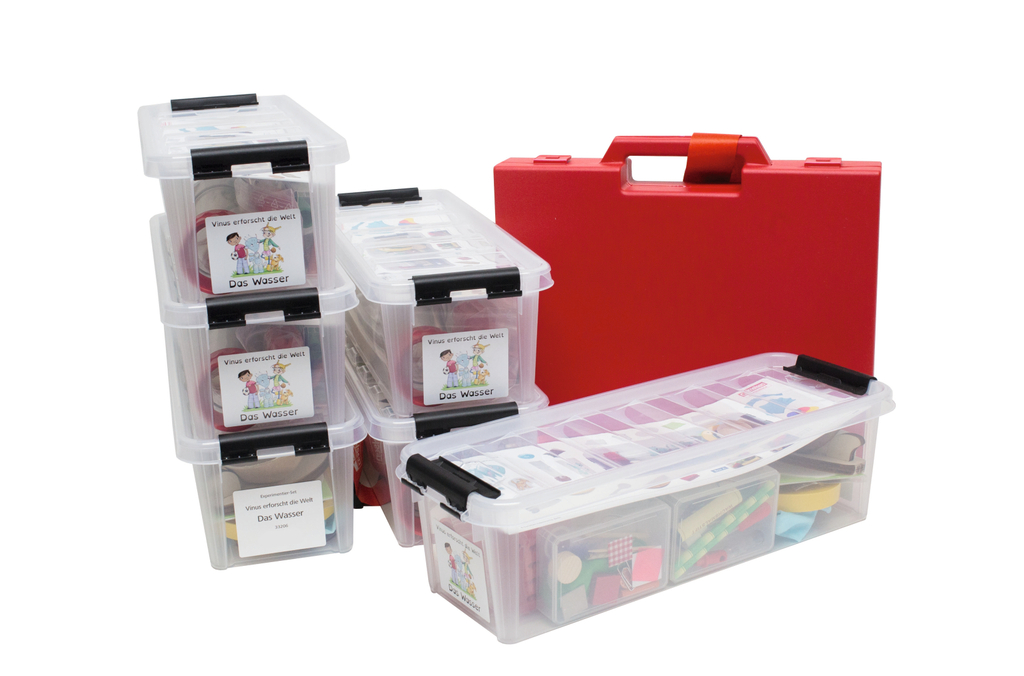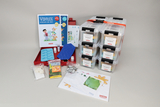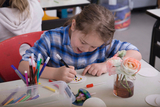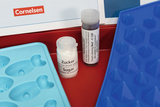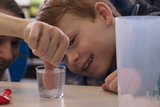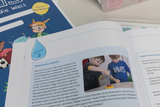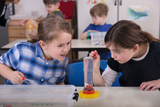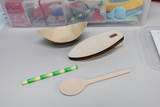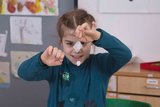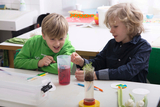Experiments on water for primary school
Experimental set for 6 groups Vinus explores the world - Topic Water
This is a typical excerpt from one of the stories about the little extra-terrestrial creature Vinus, whose space capsule makes a rough landing on Earth. Things on the Earth are perfectly normal for the children Ben and Lili and their dog Jojo, but that doesn’t mean they can really explain everything correctly. So they set off together to investigate certain phenomena.
The use of storytelling as a methodology captivates the pupils right from the start. Through stories about Vinus and his friends, topics are transposed from the instruction syllabus to the real world of the children. This gives open questions personal meaning for the children. As a result, they are excited to find the solution to the question for themselves and retain a solid understanding of the responses and interrelationships.
Vinus explores the world is an innovative series based on the storytelling method that combines stories with experimentation.
Age 7-9
Equipment for 6 groups (12 – 18 children)
And here’s how it works:
- For each topic, such as ‘Air’, there are separate stories – for the extra-terrestrial creature, they are episodes. The key points arising from an episode always lead to a concrete topic of instruction, e. g. “Air has a weight”.
- The episode incites the children to develop their own questions and conjectures. The concept story helps them do so.
- This enables each child to reach the intended conclusions individually at their own pace and in their own way. There is no right or wrong here, detours are permitted.
- The materials are precisely matched to the content of the episode, thereby maintaining motivation throughout the duration of the experiment.
- This is investigative discovery learning, which furthermore demands social skills because problems are solved together.
- The observations and findings can be recorded in the logbook individually according to the abilities of the child.
Episodes
Children learn about water and its properties
Episode 1: Off we go on a water adventure
Swimming, sinking and diving
Episode 2: Of Frogs and Flumes
Water in motion / water resistance
Episode 3: Waves, Whirlpools and Pirates
Water solubility / plant growth
Episode 4: I drink, you drink – who else ?
Physical states of water / weather
Episode 5: Rain, snow – oh no, oh no !
The first experiences with optical illusions in the transition from air to water are made. The "bend in the drinking straw" as well as the reversal of direction at "Jojo" behind the pipe fascinate the children.

The students investigate the surface tension of water as a "water mountain" on a coin or in a small, already overfilled cup. To do this, they practice fine motor skills with a pipette or drinking straw.
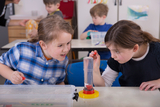
The phenomenon of buoyancy is explored and rules can be found for when materials and bodies float or sink. The properties of everyday materials provide clues that can be used to explain buoyancy and displacement.

Students apply creative solutions to make non-buoyant materials float using buoyant materials.
The controlled descent and ascent in water is explored by the students. The functioning of the swim bladder in fish or the descent of submarines can be easily understood.
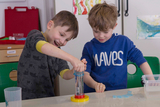
Children explore the principles of the shape and material composition of boats and develop their own buoyant constructions.
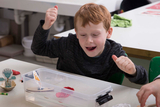
Using a variety of techniques and materials, the children imaginatively try to move the boat and surfboard in the tub. The creation of waves and the observation of this spread of movement of the water are studied with fascination.

Students explore the phenomenon of whirlpool formation as water spills out. With the help of the cooking spoon and vigorous stirring movements, funnel-shaped vortices ("water trunks") can be created.

Children learn in a unique way how webbed feet work in nature and can experience the principles on themselves with the help of the webbed feet in complete fascination.
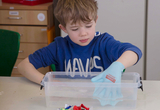
Students* learn how plants drink and also that water can be moved against gravity (using the capillary suction effect). In the context of paper chromatography, the spread of color carried by water is shown.
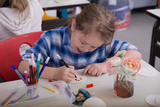
Almost enchanted, the children experience the independent "blooming" of the folded water lily flower on the water.

The students learn that substances do not simply disappear, but that sugar and salt, for example, can dissolve (in water). An extension of the experiment can be the separation of the substances that were initially combined.

Students experience the process of "drinking" in plants very vividly by leaving white flowering plants or vegetables such as celery in colored water for some time and observing the effects.
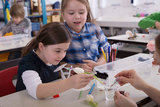
First experimental experiences with the different states of water are made. The children learn how the transitions of the states of matter solid to liquid (melting ice) and gaseous to liquid (condensation) can occur. Liquid to gaseous is examined in the homework area.

The prepared ice (diamond and fish shapes) is examined by the children in terms of its properties: how do I get ice to melt? What happens to ice in water? What effects result (temperature differences, etc.)?

The phenomenon of density anomaly of water, which is essential for survival in nature, is sufficiently explored by the children.

Children explore the properties of water using their senses. The aim is to feel water, to examine the taste and the color of water. The conditions for a reflective surface can be experienced. Sounds in and under water, of and with water are explored.

Students explore how water drops can be transported in different ways. The functionality of the pipette is tested. The children learn that water in a cylindrical cup as well as a spherical drop has a magnifying effect.

The physical characteristics of water (adhesive force, adhesion and cohesion) are explored with the help of the size-adjustable Vinus hands or paint paddles that stick together. Various small parts and everyday objects can be examined and compared with one another in terms of their properties with regard to adhesion to the Vinus hands.
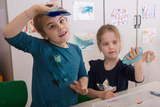
Through an enlarged support, the children get to know the principles of displacement and buoyancy of water.
Not only the existing watercraft (palm leaf boat and surfboard), but also self-constructed boats made of plasticine are carefully explored by the children in terms of their buoyancy.
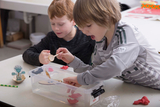
The phenomenon of water resistance is studied and the relationship between area and resistance can be experienced and deduced.
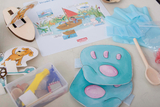
The lotus effect is studied in detail by the children. The experiment materials are used as well as the nasturtium that they have grown themselves, which exhibits this effect wonderfully on its leaves. The leaves in the immediate vicinity can also be investigated and analyzed in a planned manner.

The phenomena of germination and growth in plants are explored here. The children experience these processes and, in addition to the scientific laws, also learn about responsibility for nature and the handling and care of plant life.
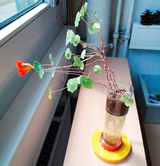
Students explore the changes in water when it freezes. For this purpose, self-collected natural objects are frozen in water and thawed again. In addition, a different salt content of the solution can become a research assignment.

The children investigate the question of why salt is spread on the roads in winter. With the help of a skill-building variant, they learn how ice can be melted by salt and even how small chunks can be fished with a string.
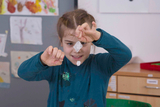
First experiences with weather phenomena and their systematic investigation are undertaken. Rain can be collected and evaporation can be studied in the classroom or at different temperatures and solar radiation (respectively near the heater in winter).

- 1 × Baking powder (5 pack.)
- 1 × °Glass with common salt (sodium chloride)
- 1 × °Glass with sugar
- 1 × Plastic box R4 320x245x50 mm
- 1 × Colouring agent, red for lab use only
- 1 × Adhesive bonding compound(Blu-Tack)
- 1 × Sewing thread, 100 m
- 1 ×
- 1 ×
- 1 ×
- 1 ×
- 1 ×
- 6 ×
- 12 ×
- 1 ×
- 1 ×
- 6 ×
- 1 ×
- 6 ×
- 6 ×
- 6 ×
- 6 ×
